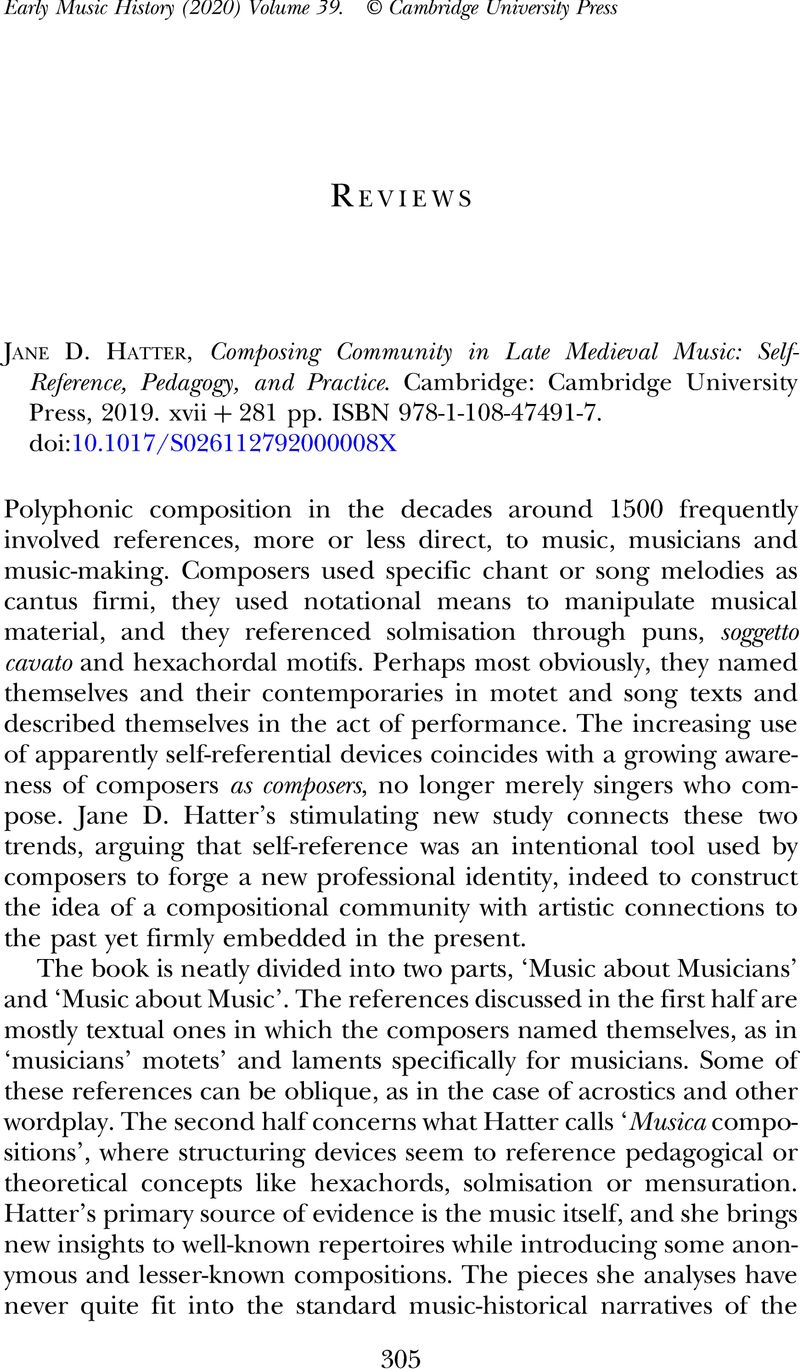No CrossRef data available.
Published online by Cambridge University Press: 04 September 2020

1 The textual phrase is missing in the other source, Vatican City, Biblioteca Apostolica Vaticana, San Pietro B 80 (VatSP B80).
2 Loyset Compère, Opera omnia, ed. L. Finscher, Corpus Mensurabilis Musicae, 15/4 (s.l., 1961), p. 36; D. J. Rothenberg, The Flower of Paradise: Marian Devotion and Secular Song in Medieval and Renaissance Music (New York, 2011), p. 165; P. Kolb, ‘Structure and Context in Fifteenth-Century Bilingual Motets’, Musica Disciplina, 61 (2018), pp. 17–63, at p. 46; J. Rifkin, ‘Compere, “Des Pres,” and the Choirmasters of Cambrai: Omnium bonorum plena Reconsidered’, Acta Musicologica, 81 (2009), pp. 55–75, at p. 56.
3 As another example, the passing references to musicians in Decantemus in hac die are related not to professional concerns (p. 80, Table 3.9) but to their spiritual concerns. Hatter considers these references to be part of the reason why Petrucci was willing to publish the anonymous motet (p. 83), though the Marian text is generic enough to have been widely usable. The ‘motto defining the ascending soft hexachord’ (p. 84) actually outlines the entire octave d to d′ or d′ to d″ (with the bass only making it up to c′), and there is no indication that a b {fl} would have been sung in any voice.
4 For some reason A. E. Planchart’s edition (The New Guillame Du Fay Opera Omnia, published online at https://www.diamm.ac.uk/resources/music-editions/du-fay-opera-omnia/) moves the text phrases around so that this does not remain the case, but it does appear to be true in the only surviving source.
5 The music example giving Hatter’s suggested text underlay follows VatSP B80. At this point Trent 91 has a variant which splits a breve into two semibreves, making Hatter’s underlay less likely. I think the Trent 91 variant is probably original, as it matches how the tenor is presented in the prima pars in both sources. Both sources also join the relevant notes in ligature, e {fl}′–d, which Hatter’s example, though otherwise marking ligatures, does not indicate.
6 R. C. Wegman, ‘From Maker to Composer: Improvisation and Musical Authorship in the Low Countries, 1450–1500′, Journal of the American Musicological Society, 49 (1996), pp. 409–79, at p. 470.
7 The others are Eloy d’Amerval’s Missa Dixerunt discipuli, the Credo of Brumel’s Missa Ut re mi fa sol la, Obrecht’s Inter preclarissimas virtutes, and the much earlier anonymous motet Inter densas/Imbribus/Admirabile.
8 On mensural transformation and homography see especially E. Zazulia, ‘The Transformative Impulse’, in A. M. Busse Berger and J. Rodin (eds.), The Cambridge History of Fifteenth-Century Music(Cambridge, 2015), pp. 587–601, which Hatter cites, and Zazulia, ‘Verbal Canons and Notational Complexity in Fifteenth-Century Music’ (PhD diss., University of Pennsylvania, 2012). I discussed instances of homography in motets in ‘Structure and Context’.
9 This is effectively mentioned at p. 72, n. 57. I discussed it further in my ‘Structure and Context’, pp. 39–42.
10 M. Bent, ‘What is Isorhythm?’, in D. B. Cannata, G. I. Currie, R. C. Mueller, and J. L. Nádas (eds.), Quomodo cantabimus canticum? Studies in Honor of Edward H. Roesner (Middleton, WI, 2008), pp. 121–43.